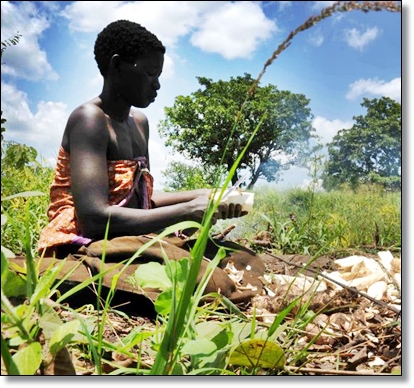Uganda: Agriculture Sector Budget Should focus on DSIP and Local Governments

 |
| A Ugandan farmer peels her cassava |
The agriculture sector remains among the lowest ranked sectors in the national budget. The sector has not received more than 5% share of the national budget since 2009/10. The total budget allocation for the agriculture sector for FY 2012/13 was Shs 379.04 billion which is 3.5% of the total national budget. The 2013/2014 projection is 3.2% - even if we stretch to the total direct and indirect allocation to the sector, the total allocation will not exceed 5% of the total national budget. Either way, the allocation to the sector is way below the Maputo/ Comprehensive Africa Agriculture Development Program (CAADP) declaration (target) of at least 10% of the national budget- that Uganda committed to implement.
Due to low funding, the agriculture sector is facing challenges, among them are: lack of implementation of the Shs 1.4 trillion national action plan on poverty reduction and enterprise selection; recruitment of staff at district Local governments; lack of non-wage budget to implement the MAAIF structure at headquarters; failure to provide water for agriculture production facilities; lack of continuous funding for technology development; and inability to fund 100 farmers per parish under NAADS and evident struggle to manage devastating wilts like banana bacterial wilt and coffee wilt.
Sadly, looking at inter-sectoral analysis of the agriculture budget over the last three years, one notes that 60 percent of the sector budget is allocated to central government agencies and the headquarters. Despite the fact that Local governments implement majority of the sector DSIP activities, only 40% of the sector budget is allocated to Local Government’s programmes under advisory services and production services. Apart from NAADS, there is virtually no other government funding for agriculture at Local Government levels.
Districts continue to face serious problems in raising local revenues to support the agriculture and other sectors. For example, Amuru collects only 0.7 percent of its total budget, Luwero at 1.2 percent of its entire budget and Nebbi at 3.3 percent! Can these districts marshal capacity to deliver local specific services especially those in the agriculture sector? The answer is no. Indeed most local governments depend on Central Government (CG) transfers. For 2012/2013 Financial Year, average CG grants constituted over 70 percent, 90 percent and 92 percent of Amuru, Luwero and Nebbi DLG budgets respectively for the last four years. The CG transfers are biased towards national budget priorities and are largely conditional in nature. This means local governments lack the discretionary powers to allocate resources and ensure that peculiar needs of the communities in areas such as agriculture and livelihoods are executed.
District Agriculture Budget Allocations also show that agriculture is not among the key priorities of the District Local Government (DLG) budgets. The share of the production sector (which constitutes agriculture) to the total DLG budget is less than 10 percent, averaging 6.7 percent, 7.3 percent and 8.4 percent in Amuru, Luwero and Nebbi DLGs respectively over the last four FYs (i.e. 2009/10 – 2012/13). Apart from NAADS, there is no other visible government agriculture development program at LG levels. Yet NAADS program mainly focuses on advisory services, and provision of inputs; other agriculture value chains such as pests and diseases control, post-harvest handling and marketing are largely underfunded.
Generally sub-counties allocate more funds in their budgets towards agriculture compared to the central and DLGs. Over half of the entire sub-county budget is spent on agriculture related programmes. The higher share of agriculture in the sub-county budget is more encouraging especially given the fact that the sub-county is the front-line service delivery organ of government. The biggest challenge is that the actual amounts are too meager to create meaningful impact on the agricultural development in the county.
The Uganda government should exploit the possibility of establishing an Agricultural Bank that will explicitly focus on farmers credit needs, hedge against risks like crop failures and price volatilities of agro-products. MAAIF needs to enhance its linkages with LGs through recruiting more staff and empowering the District Production offices. MAAIF needs to ensure that the DSIP is effectively implements by harmonizing its budget estimates with the Medium term Framework (MTEF) and annual budgets. Government needs to recruit more extension staff at the sub county level in a bid to address the inadequate staffing. Government needs to develop client’s charters between the service providers and communities/ beneficiaries.
Local Governments (both district and sub-counties) need to improve on their planning and budgeting process through involving the key stakeholders such as farmers. They should increase access to budget information through display of budget information on public notices boards, or announcements on radios and other local media where possible. The foregoing will tame corruption in the sector and increase service delivery efficiency.
By Morrison Rwakakamba
Chief Executive Officer, Agency for Transformation
mrwakakamba@gmail.com
